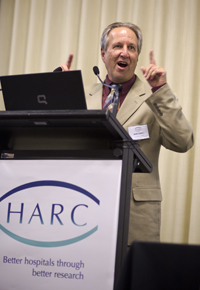
Not a single healthcare organisation in the world is measuring the scale of diagnostic error in its patients, international expert Dr Mark Graber told a Sydney healthcare audience last week.
Addressing the 9th Hospital Alliance for Research Collaboration (HARC) Forum, Dr Graber said research data had estimated the incidence of diagnostic error to be in the range of 10% to 15%. But actual incidence data was needed to confirm what was happening in practice and determine what fraction of these errors resulted in harm.
Australian estimates
Extrapolated estimates for Australia put the number of diagnostic errors at 140,000 cases per year, with 21,000 cases of serious harm and 2000 to 4000 deaths.
“Diagnosis is important to me as an internist and it is also important to our patients; if it is so important to all of us why is [diagnostic error] not being discussed?” he said.
This lack of discussion was surprising given that diagnostic error was an important driver of medical malpractice claims. Part of the problem was a lack of consensus on what constitutes a diagnostic error. But the most significant impediment was that tools now used in patient safety monitoring failed to detect diagnostic errors.
Ways to measure error
Dr Graber, who founded the Society to Improve Diagnosis in Medicine, and who is a Senior Fellow at RTI International and Professor Emeritus of Medicine, State University of New York, said there were a number of possible ways to measure diagnostic error that were worthy of trials.
These included:
- ‘Trigger tools’ to prompt further investigation such as unplanned hospital admissions within two weeks of a primary care visit
- Exploring innovative ways to encourage doctors to report error
- Following up patients after healthcare visits, and encouraging them to speak up and keep track of their healthcare records.
Making progress
But to make progress we would first need to overcome the inertia created by a lack of ownership of the problem. This was where policy makers could make a real difference, Dr Graber told the audience.
Those who managed healthcare systems could begin efforts to measure the diagnostic error rate, create ‘space’ to talk about error, address the common system flaws that contribute to diagnostic error, provide decision support resources and develop pathways for feedback, he said.
And doctors could bring system errors to attention, insist on feedback from patients and peers and seek help through collaborating with colleagues and using decision support resources.
Local perspective
A panel of speakers at the forum gave their perspective on diagnostic error in Australia.
President of the Australian Patient Safety Foundation Professor Bill Runciman said Dr Graber’s work was highly relevant to Australia. There was a “stunning congruence” between the problems faced here and those being experienced in other western countries, he said.
HARC is a partnership between the Sax Institute, the Clinical Excellence Commission and the Agency for Clinical Innovation that drives innovative thinking about emerging challenges in healthcare and aims to improve health and hospital services through research.
Find out more
- Recent publications on diagnostic error by Dr Mark Graber and colleagues:
Bringing diagnosis into the quality and safety equations — JAMA
Cognitive interventions to reduce diagnostic error: a narrative review — BMJ Quality & Safety - Learn more about HARC
- Join the HARC network to receive copies of the HARC e-Bulletin and notification of HARC Forums
- Watch our short video: Five questions with Dr Mark Graber
